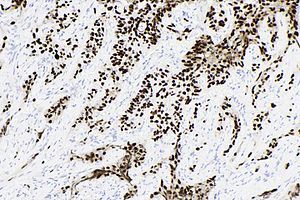Paired box gene 8
Jump to navigation
Jump to search
Paired box gene 8, commonly known by the abbreviation PAX8, is a commonly used immunostain in gynecologic pathology and genitourinary pathology.
| Paired box gene 8 | |
|---|---|
| Immunostain in short | |
 PAX8 staining in a poorly differentiated carcinoma. | |
| Abbreviation | PAX8 |
| Use | RCC versus other, gynecologic tract malignancy versus other |
| Subspeciality | gynecologic pathology, genitourinary pathology |
| Normal staining pattern | nuclear stain |
| Positive | renal cell carcinomas, renal oncocytoma, thyroid tumours, serous carcinoma, endometrial carcinomas |
Tumours with positive staining
- Thyroid tumours ~ 90%.[1]
- Renal cell carcinomas ~ 90%.[1]
- Renal oncocytomas ~ 80%.[1]
- High-grade ovarian serous carcinomas ~ 99%.[1]
- Nonserous epithelial ovarian neoplasms ~ 70%.[1]
- Endometrial carcinomas ~ 98%.[1]
- Pancreatic neuroendocrine tumour ~ 74%.[2]
- Can help differentiate from lung NETs.
- Epithelial component of thymic tumors 77-100% depending on sub-type[1][3]
May be positive
- Peritoneal malignant mesothelioma (5 +ve of 27[4]).
Negative staining
- Urothelial carcinoma - can be positive (3 positive/18 bladder tumours[1]).
- Lymphoma (beware false positive staining due to polyclonal PAX8 antibodies cross-reacting with PAX5)[5]
- Malignant melanoma.[6]
- Salivary gland and salivary gland tumours.[7]
See also
References
- ↑ 1.0 1.1 1.2 1.3 1.4 1.5 1.6 1.7 Laury, AR.; Perets, R.; Piao, H.; Krane, JF.; Barletta, JA.; French, C.; Chirieac, LR.; Lis, R. et al. (Jun 2011). "A comprehensive analysis of PAX8 expression in human epithelial tumors.". Am J Surg Pathol 35 (6): 816-26. doi:10.1097/PAS.0b013e318216c112. PMID 21552115.
- ↑ Sangoi, AR.; Ohgami, RS.; Pai, RK.; Beck, AH.; McKenney, JK.; Pai, RK. (Mar 2011). "PAX8 expression reliably distinguishes pancreatic well-differentiated neuroendocrine tumors from ileal and pulmonary well-differentiated neuroendocrine tumors and pancreatic acinar cell carcinoma.". Mod Pathol 24 (3): 412-24. doi:10.1038/modpathol.2010.176. PMID 20890270.
- ↑ Weissferdt A, Moran CA (September 2011). "Pax8 expression in thymic epithelial neoplasms: an immunohistochemical analysis". Am. J. Surg. Pathol. 35 (9): 1305–10. doi:10.1097/PAS.0b013e3182260735. PMID 21836478.
- ↑ Chapel DB, Husain AN, Krausz T, McGregor SM (December 2017). "PAX8 Expression in a Subset of Malignant Peritoneal Mesotheliomas and Benign Mesothelium has Diagnostic Implications in the Differential Diagnosis of Ovarian Serous Carcinoma". Am. J. Surg. Pathol. 41 (12): 1675–1682. doi:10.1097/PAS.0000000000000935. PMID 28877056.
- ↑ Moretti L, Medeiros LJ, Kunkalla K, Williams MD, Singh RR, Vega F (February 2012). "N-terminal PAX8 polyclonal antibody shows cross-reactivity with N-terminal region of PAX5 and is responsible for reports of PAX8 positivity in malignant lymphomas". Mod. Pathol. 25 (2): 231–6. doi:10.1038/modpathol.2011.162. PMID 22037256.
- ↑ Tacha, D.; Zhou, D.; Cheng, L. (Jul 2011). "Expression of PAX8 in normal and neoplastic tissues: a comprehensive immunohistochemical study.". Appl Immunohistochem Mol Morphol 19 (4): 293-9. doi:10.1097/PAI.0b013e3182025f66. PMID 21285870.
- ↑ Butler RT, Alderman MA, Thompson LD, McHugh JB (March 2015). "Evaluation of PAX2 and PAX8 expression in salivary gland neoplasms". Head Neck Pathol 9 (1): 47–50. doi:10.1007/s12105-014-0546-4. PMC 4382472. PMID 24771139. https://www.ncbi.nlm.nih.gov/pmc/articles/PMC4382472/.